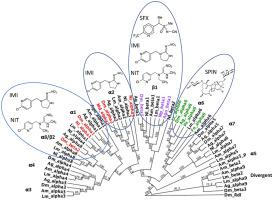Insect Biochemistry and Molecular Biology ( IF 3.8 ) Pub Date : 2021-02-03 , DOI: 10.1016/j.ibmb.2021.103547 Trent Perry 1 , Wei Chen 1 , Razi Ghazali 1 , Ying Ting Yang 1 , Danielle Christesen 1 , Felipe Martelli 1 , Chris Lumb 2 , Hang Ngoc Bao Luong 1 , Judith Mitchell 1 , Jessica K Holien 3 , Michael W Parker 4 , Thomas C Sparks 5 , Philip Batterham 1

|
Insecticides remain valuable tools for the control of insect pests that significantly impact human health and agriculture. A deeper understanding of insecticide targets is important in maintaining this control over pests. Our study systematically investigates the nicotinic acetylcholine receptor (nAChR) gene family, in order to identify the receptor subunits critical to the insect response to insecticides from three distinct chemical classes (neonicotinoids, spinosyns and sulfoximines). Applying the CRISPR/Cas9 gene editing technology in D. melanogaster, we were able to generate and maintain homozygous mutants for eight nAChR subunit genes. A ninth gene (Dβ1) was investigated using somatic CRISPR in neural cells to overcome the low viability of the homozygous germline knockout mutant. These findings highlight the specificity of the spinosyn class insecticide, spinosad, to receptors containing the Dα6 subunit. By way of contrast, neonicotinoids are likely to target multiple receptor subtypes, beyond those receptor subunit combinations previously identified. Significant differences in the impacts of specific nAChR subunit deletions on the resistance level of flies to neonicotinoids imidacloprid and nitenpyram indicate that the receptor subtypes they target do not completely overlap. While an R81T mutation in β1 subunits has revealed residues co-ordinating binding of sulfoximines and neonicotinoids differ, the resistance profiles of a deletion of Dβ1 examined here provide new insights into the mode of action of sulfoxaflor (sulfoximine) and identify Dβ1 as a key component of nAChRs targeted by both these insecticide classes. A comparison of resistance phenotypes found in this study to resistance reported in insect pests reveals a strong conservation of subunit targets across many different insect species and that mutations have been identified in most of the receptor subunits that our findings would predict to have the potential to confer resistance.
中文翻译:

烟碱乙酰胆碱受体亚基在新烟碱类、亚砜亚胺和多杀菌素杀虫剂在黑腹果蝇中的作用方式中的作用
杀虫剂仍然是控制对人类健康和农业产生重大影响的害虫的宝贵工具。更深入地了解杀虫剂目标对于保持对害虫的这种控制非常重要。我们的研究系统地调查了烟碱型乙酰胆碱受体 (nAChR) 基因家族,以确定对昆虫对三种不同化学类别(新烟碱类、多杀菌素和亚砜亚胺)杀虫剂的反应至关重要的受体亚基。在黑腹果蝇中应用 CRISPR/Cas9 基因编辑技术,我们能够生成和维持八个 nAChR 亚基基因的纯合突变体。第九个基因(Dβ1) 在神经细胞中使用体细胞 CRISPR 进行研究,以克服纯合种系敲除突变体的低活力。这些发现突出了多杀菌素类杀虫剂多杀菌素对含有 Dα6 亚基的受体的特异性。相比之下,新烟碱类物质可能针对多种受体亚型,而不是先前确定的那些受体亚基组合。特定 nAChR 亚基缺失对果蝇对新烟碱类吡虫啉和烯啶虫胺的抗性水平的影响存在显着差异,表明它们靶向的受体亚型并不完全重叠。虽然 β1 亚基中的 R81T 突变揭示了协调亚砜亚胺和新烟碱类化合物结合的残基不同,但Dβ1缺失的耐药谱此处检查提供了对 sulfoxaflor(亚砜亚胺)作用方式的新见解,并将 Dβ1 鉴定为这两种杀虫剂类别所针对的 nAChR 的关键成分。将本研究中发现的抗性表型与害虫中报告的抗性进行比较,揭示了许多不同昆虫物种的亚基目标的强烈保守性,并且在我们的研究结果预测有可能赋予的大多数受体亚基中已鉴定出突变反抗。



























 京公网安备 11010802027423号
京公网安备 11010802027423号